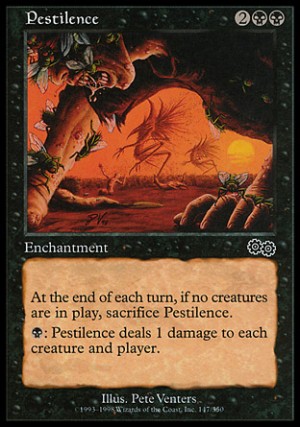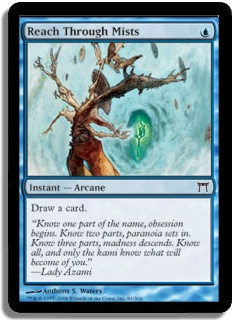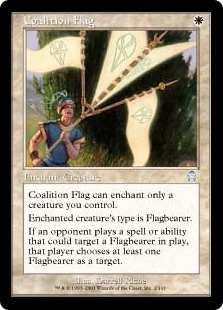Are you a Quiet Speculation member?
If not, now is a perfect time to join up! Our powerful tools, breaking-news analysis, and exclusive Discord channel will make sure you stay up to date and ahead of the curve.
Everybody knows that 4-3-2-2 drafts are awful value. The prize pool for them includes one fewer pack than an 8-4 or a swiss draft. Additionally, you really don’t increase your bankroll by very much when you win them. This in mind, a person would have to have a pretty good reason (or a total lack of any) to play in a 4-3-2-2.
So why is it that I’m currently in a queue for such a low EV draft?
Because Invasion block is sweet.
If you were unaware, there are some pretty neat things happening on MTGO right now on account of its 10th anniversary. At first I was just excited to crush some gold queues, but I also have an affinity for experiencing different draft formats.

Most of the time I end up being widely disappointed by older limited formats. Tempest block was a somehow worse version of Zendikar. Urza block was miserable if you weren’t the guy playing Pestilence. Invasion block, however, is easily in the top five draft formats of all time.
Avacyn Restored has been extremely lame to draft in my limited (no pun intended) experience with it. For the most part, you just pick two colors and pick the best card for those colors in each pack.
Invasion is about thirteen times more complex. For starters, you can play anywhere from two-five colors*, and within each color combination there are a lot of choices to be made about exactly what you want your deck to do. In only seven drafts, I’ve played everything from very aggressive Gaea's Might decks to extremely durdly five-color control decks. The best part is that I still have no idea which route is better, if there even is a correct answer to that question.
*I suppose you could also try mono-color, but I sure have no intention of it.
I’ll say right off the bat that if you’re looking to grind value out of MTGO, then drafting IPA isn’t in your best interest. The 4-3-2-2 prize support is embarrassing and the money rares are few and far between (though, to be fair, there are a few commons that are worth .25-1 ticket).
Of course, playing limited on MTGO isn’t exactly a high EV venture in the first place. If you’re drafting on the regular you’re either doing it to refine your skill set or to have a good time. Either way, IPA delivers as both a skill intensive and immensely fun format.
Here’s where I think Invasion shines as compared to other limited environments:
Interesting Mana Fixing
If you compare the mana fixing in IPA to that of Ravnica or Shards of Alara, you’ll quickly notice that you had to work a lot harder for it in IPA.
Compare the Lair cycle, the tri-land cycle and bouncelands:
I can’t say definitively which I’d most want to have in a given deck, but I can say with certainty that it wouldn’t be the Lairs. Having such drawbacks on color-fixing forces a player to make tough decisions about how deep they want to go in terms of colored mana requirements.
Invasion’s Cameo cycle isn’t super different from Ravnica’s signets, but the Cameos, like most colorless fixers in IPA, are uncommon.
I really like these discrepancies in power level and rarity as they make it more difficult for a player to just take the best card/best fixer in every pack.
The coolest fixing available in IPA, IMO, are the creatures that tap to change land types. When I first heard that Dream Thrush was great in IPA, I was very confused. After using it on my opponent’s upkeep to color-screw them for the first time, things made a lot more sense. Not only that, but changing a player’s Domain count at instant speed has quite a few implications.
Which leads me to the next reason that IPA is awesome…
Spell Modality
This is probably the most important aspect to me with regard to what makes a Magic card interesting.
I think that Geist of Saint Traft is extremely boring. It does exactly two things, and it does half of them poorly.
Snapcaster Mage, on the other hand, does approximately four billion things. You can tell a lot about the strength of a player by the way that they sling their Tiagos.
For this reason I really enjoy Kicker as a block mechanic. It constantly forces a player to assess when they should cast their spells and how greedy they can afford to be. Some of the spells are rather obvious, such as Ardent Soldier, but when and how to kick a Nightscape Battlemage can have a dramatic impact on a game.
The Disciples of IPA are another great example of spell modality. This is not only because of their multiple abilities, but also because they can fill completely different roles in completely different decks.
Take Dega Disciple for example. The card is reasonable for a slower black/white deck, an aggressive red/white deck or a midrange style black/red/white deck. What’s really interesting is that the power level of Dega Disciple changes dramatically depending on which of these archetypes you’re playing, as it’s a much better aggressor than a defender.
Additionally, each Disciple makes a player choose what (if anything) they want to do with it every turn. I'm all about cards that involve a lot of decision making.
CANTRIPS!

“Draw a card.”
Is there a more satisfying sentence in all of Magic? I mean, “Counter target spell” and “The land continues to burn after Obsidian Fireheart has left the battlefield” come to mind, but there’s just something about cantrips.
For starters, there are cards like Kavu Climber that have solid bodies (it was a different time) and then have the cantrip as a completely free card. Having the ability on a creature is even sweeter when you throw some Gating creatures like Steal Leaf Paladin into the mix.
Of course, more commonly cantrips appear on cards that are more marginal. In a couple of my drafts I was able to pick up a Lashknife Barrier really late into pack two. It’s fair to say that the card would probably be unplayable without the cantrip, but that’s irrelevant. So long as a card doesn’t have any unreasonable drawbacks (of which costing three is not one), adding a cantrip to it makes it playable.
This really opens up the possibilities for some very unique situations. For example, Stifle probably isn’t going to end up in any 40 card decks. Bind, however, can really surprise a player activating a Disciple.
Hobble is another interesting card. Pacifism effects are generally very good in limited, but Hobble might’ve been pretty loose without the cantrip considering all the Gating creatures. In a format without Gating, Hobble would probably be really, really good. Imagine having it in Rise of the Eldrazi, for example. Very cool design in my opinion.
Don’t even get me started on how insane Repulse is.
Flagbearers
There aren’t exactly a lot of these, but I’m pretty much in love with Coalition Honor Guard.
Seriously, these guys are sweet. The obvious implication is that they mess with your opponents removal spells - they even invalidate damage-based ones to an extent. On a more interesting level they essentially blank your opponent’s removal spells and soak up all of their targeted Disciple abilities.
The only issue that I take with Flagbearers is that I never got to cast one in a physical game of Magic. It’s really satisfying watching an opponent tap and untap their mana when you control a Flagbearer. I can only imagine how much better it feels without them having an online client to tell them they can’t do what they want to do.
~
As I said earlier, drafting IPA on MTGO isn’t exactly a gold mine. However, if you’re in the market for a quality draft, then I couldn’t recommend it enough.
-Ryan Overturf





There are very few things better in limited than watching your opponent burn premium removal like Agonizing Demise or Terminate on some stupid 1/1 that wants to steal his Armadillo Cloak. Maybe casting Repulse after the Cloak actually comes down.
I really enjoyed your article!